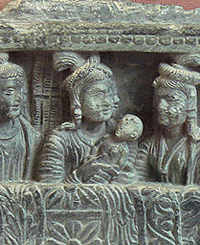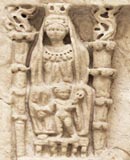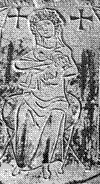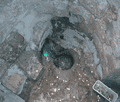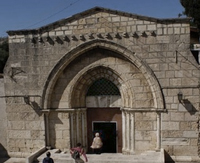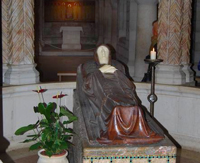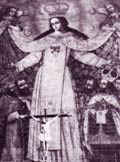The Mythical Virgin Mother - Immaculate Deception
From Merest Shadow to Queen of Heaven
- My soul doth magnify the Lord,
- And my spirit hath rejoiced in God my Saviour.
- For he hath regarded the low estate of his handmaiden:
- for, behold, from henceforth all generations shall call me blessed.
- For he that is mighty hath done to me great things;
- and holy is his name.
- And his mercy is on them that fear him from generation to generation.
- He hath shewed strength with his arm;
- he hath scattered the proud in the imagination of their hearts.
- He hath put down the mighty from their seats,
- He hath filled the hungry with good things;
- and the rich he hath sent empty away.
- He hath helpen his servant Israel, in remembrance of his mercy;
As he spake to our fathers, to Abraham, and to his seed for ever.
God only knows who was also in the room (or was it a cave? ) to record all this! Perhaps she wrote her memoirs. (In truth, the piece is an obvious adaptation of the song of Hannah in 1 Samuel 2). But after this soliloquy Mary has not a word to say for herself. She witnesses visits of shepherds and wise men and ‘ponders’ (Luke 2.16); she is taken to Egypt (Matthew 2.13.18) and brought back to Galilee; she puzzles at her twelve-year old’s claim to messiahship (Luke 2.48,52); she witnesses the turning of water to wine (John 2.1,12); she is rejected by her super-star off-spring (Luke 8. 19,21); she witnesses his crucifixion (John 19.25,27); and she waits for the holy spirit (Acts 1.14). Her ultimate fate is not revealed and she is credited with no role at all in the creation of the Christian Church.
Pagan Model
Yet upon this sketchy outline a full-bodied character was to be fleshed out soon enough by ‘creative’ Christian scribes. Pagan gods, as often as not, were supposedly sired by virgin goddesses – quite commonly as a result of impregnation by a sun-beam. The resultant sun-god was depicted as an infant at the breast of his mother – the ‘Madonna and Child’ no less! Such iconography is to be found all the way from Egypt to China. The Romans’ own virgin goddess, Vesta, was served by women who maintained her perpetual flame and their own chastity for thirty years.
Justin ‘Martyr’, a Greek from Palestine who had fled to Ephesus at the time of Bar Kochbar’s revolt, adopted the embryonic Christianity he found in the city with relish. But Justin’s enthusiasm came with a prior familiarity of Greek classics. In his adopted city the venerable cult of the moon goddess Artemis (or Diana as the Romans called her) had been the eternally virgin protector of youth, chastity and fertility for a millennium. In the process the city had become a wealthy place of pilgrimage – the world’s first bankers had been the priests of Artemis.
Becomes a Virgin
The next major contribution to the Mary legend came in the mid-second century, with the so-called ‘Protevangelium of James’, a document so clearly fictitious that it has been rejected even by the Catholic church since the Renaissance.
Nonetheless, this pious nonsense underpins much of current belief regarding the Blessed Virgin, providing such information as the names of Mary’s parents and grandparents, a story of her prodigious childhood (“left at the Temple from the age of three” – an event without precedent in Jewish custom!); her early commitment to chastity (why – did she know what was coming?); daily chats with angels; and a ‘safe’ marriage at puberty to the elderly widower Joseph. With this embellished ‘history’, Mary began her ascendancy as a mediator, more approachable than Christ because of her ‘humbling’ femininity. Artistic representations of her began to proliferate, uncannily like the prototype they were based upon – Artemis, the goddess with more than a thousand years of marketing success behind her!
A century later the ‘Gospel of the Nativity of Mary’ (well, we can never have enough gospels, can we?) added background detail. This story of Mary’s birth to ancient parents Anne and Joachim was a simple re-write of Samuel’s birth to Hannah and Elkanah already to be found in 1 Samuel. But now we learn of such delights as Mary’s grandmother’s seven marriages. Six husbands were dispatched by the Lord for feeling lust while having sex. Thankfully the seventh was inert during the sinful act, or we would not have had Anne, Mary, Jesus and the whole nine yards!
Remains a Virgin
“In the 4th century the idea came to prominence that Mary’s hymen had remained intact through the birth of Jesus… Mary’s in partu virginity was an issue addressed by all the great theologians of the period.”
As the doctrine of Mary’s ‘perpetual virginity’ became widespread so did confusion among theologians over the supposed siblings of Jesus. They had to be harmonized with the new dogma, so ‘brothers and sisters’ became ‘cousins, step-siblings’, etc.
The fourth century was particularly favourable to the thriving Mary cult, largely thanks to the peripatetic activities of the Empress Helena. As mother of Constantine, she probably felt a particular affinity with the original mother of a Lord of the World. Helena positively invented ‘ecclesiastical archaeology’ (or at least the shrine-creation business).
Everywhere she went in the ‘Holy Land’ she found ‘evidence’ of Christ and ordered the construction of churches at the spot: the cave of the nativity (or so the locals said), the house of the last supper (or so the locals said), the garden of Gethsemane (or so the…), the hill of crucifixion, the empty tomb, the cross itself, even the very tree from which the wood was cut! And sure enough, Helena ‘found’ the very location (a cave) in Nazareth where the angel Gabriel had made his ‘announcement’ to Mary. Like every other shrine it thereafter became the recipient of imperial patronage and profitable pilgrimage. With the shrine went a Mary festival, the ‘Annunciation’. Unfortunately for the town of Capernaum – supposedly the chief site of Jesus’ ministry – Helena did not get that far – and the town was lost to history!
Immaculate Deception
In other words, here was an attempt to call a halt to the continuing speculation as to just how far human, and just how far god, was the divine carpenter. He was God, part of the “Trinity” no less, and Mary was his Mother.
The Byzantine Romans had a particular affection for court ritual and regalia and Mary as a queen, complete with crown and sceptre, appealed much more to imperial appetites than a shadowy peasant woman. Like Jesus himself, she had ‘gone royal’ and was elevated into the sainthood.The sixth century Council of Constantinople (553 AD) went on to endorse as dogma Mary’s “perpetual virginity”. The “purity” of virginity, it seems, is closer to the “purity” of God.
Getting a Death or two
By the seventh century, creative writers had replaced the limp ending of the Mary story with something altogether more satisfying. John Damascene (together with Gregory of Tours) developed the idea that Mary’s corporal body (and not just her spirit) had been ‘assumed’ into Heaven (again, paralleling the career of her illustrious son). John lived in Umayyad Damascus and his inspiration may well have been the claim made by upstart Islam that Muhammad had ‘ascended to Heaven’, supposedly in the year 620 (Qur’an, surah 17.1).
The doctrine of Mary’s Assumption was defined as dogma as recently as 1950 by Pope Pius XII. In his Munificentissimus Deus, the pope left open the question of Mary’s actual death, with the result that Catholics differ on whether Mary actually died before she was “assumed” into heaven and, if so, whether her soul arrived three days ahead of her body. The Orthodox Church uses the word Dormition for the same preposterous event.
Rise and Rise
By the ninth century Mary had all but eclipsed the god-man himself – and Mary could be whatever the Church hierarchy wanted her to be.
Sinless
In the first writing of the birthing of Mary, she is no more ‘immaculate’ than anyone else (and we all know original sin is passed on by sex). All the early Church Fathers agreed that Christ alone had been born without sin. They had no doubt: Mary had been a sinner. However, since Mary’s womb represented a temporary home for the gestating superhero a tainted womb raised theological difficulties about purity – if, that is, one stopped to think about such things.
In the thirteenth century a bitter doctrinal dispute led to fighting between Dominicans (‘maculates’) and Franciscans (‘immaculates’). The issue was never fully resolved until the nineteenth century, when the autocratic Pope Pius IX endorsed the dogma of ‘immaculate conception’ as the opening gambit in his move towards ‘papal infallibility’.
Only in 1854 could the world be sure that Mary had been ‘conceived normally but without sin’! Until then, ‘perpetual virginity’, the nonsense developed by Jerome and Athanasius in the fourth century, had sufficed to vouchsafe Mary’s purity.
Already a goddess, its hardly surprising that outbreaks of Marian miracles were endemic throughout the Middle Ages (and continue in our own time!) Less than God himself but considerably more than human, blessed as a female with infinite ‘humility’, she was seen as an intercessory to whom mere mortals could appeal on ‘lesser’ matters. She was, quite simply, the most important woman that had ever lived.
The cult was unstoppable. Whereas most saints had only one holy day or feast, the Holy Mother had one every few weeks and her own chapel in every church in Christendom. Eventually, even the Catholic Church had to call a halt to the galloping fantasy by reminding the faithful that Mary had to be seen as ‘completely dependent on the Son’. But it was all too much for the Protestants of the Reformation. In their hands Mary was reduced once more to a passive, obedient role, a shadow, somewhere in the background.
Defined by her virginity, lauded for limitless humility and submission, she is the idealized woman of misogynistic fanatics, in her own words a ‘handmaid (i.e. slave) of the Lord’.
Mary starts regular shuttle service between Heaven and Earth

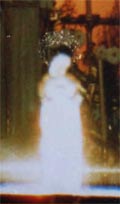
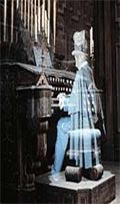
The Blessed Virgin Mary – A Saint for All Seasons
What a Girl!
Sources:
- Graham Phillips, The Marian Conspiracy (Sidgwick & Jackson, 2000)
- Marina Warner, Alone of All Her Sex (Picador, 1976)
- John Shelby Spong, Liberating the Gospels (Harper, 1996)
- John Shelby Spong, Born of a Woman (Harper, 1992)
- Robin Lane Fox, The Unauthorized Version (Penguin, 1991)
- Leslie Houlden (Ed.), Judaism & Christianity (Routledge, 1988)
- W.H.C. Frend, The Rise of Christianity (Darton, Longman & Todd, 1984)
- Riane Eisle, The Chalice & the Blade (Harper Collins, 1987)
- Ruth Harris, Lourdes: Body & Spirit in the Secular Age (Allen Lane, 19990
- Roy A. Varghese, God Sent – A History of the Accredited Apparitions of Mary (Crossroad, 2000)
Related articles
Acts of the Apostles – Linking Rome back to the Godman
St George – The Pork Salesman who became England’s Patron Saint
The Papal Princes – Christian Lords of Hell on Earth
“Brother James” – Radical Jew Sanitized into Pious Christian Martyr
Virgin Queen
In 1950 Mary’s bodily assumption into heaven became dogma; in 1945 Pius XII had proclaimed her Queen; while in 1964 – after the commencement of the Second Vatican Council – she became Mater Ecclesiae …
"Our Lady of Guadeloupe"
A timely apparition – and a good measure of violent terrorism – secured the conversion of 8 million Aztecs.
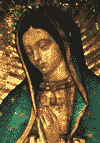
Hail Mary!
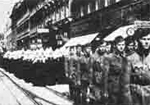
Song of Hannah
1 Samuel 2.1,10.

